In the rapidly evolving landscape of quantum technology, precision at the tiniest scales often holds the key to groundbreaking advancements. Recently, a team of Russian scientists has pushed the boundaries of measurement and manipulation to unprecedented levels, unveiling a sub-ångström technology poised to transform the architecture of next-generation quantum processors. This pioneering development promises to enhance the control and stability of quantum bits, potentially accelerating the realization of more powerful and reliable quantum computers. In this article, we explore how this remarkable innovation could reshape the future of quantum computing and what it means for the broader scientific community.
Breakthrough in Sub-Ångström Precision Enhances Quantum Processor Fabrication
Russian researchers have achieved an extraordinary leap in precision engineering by developing a cutting-edge technology capable of fabricating quantum processor components with sub-ångström accuracy. This level of control, surpassing 0.1 nanometers, allows for atomic-scale manipulation of materials, drastically reducing defects and enhancing qubit coherence times. The breakthrough unlocks a new regime in quantum processor manufacturing, enabling devices that are not only more stable but also scalable for widespread quantum computing applications.
The novel technology relies on a combination of ultra-fine lithography and real-time atomic feedback systems, which together facilitate pinpoint adjustments during the fabrication process. Key advantages include:
- Improved Qubit Fidelity: Lower error rates by minimizing atomic-level imperfections.
- Enhanced Material Uniformity: Consistent layer thicknesses and flawless interfaces.
- Scalable Production: Potential for mass-manufacturing quantum chips without performance loss.
| Parameter | Previous Tech | New Sub-Ångström Tech |
|---|---|---|
| Precision | ±0.5 nm | ±0.05 nm |
| Qubit Error Rate | 1 in 10,000 | 1 in 100,000 |
| Layer Uniformity | ±2% | ±0.2% |
Exploring the Impact of Ultra-Scale Technology on Quantum Computing Performance
Ultra-scale technology is rapidly transforming the landscape of quantum computing, pushing performance boundaries well beyond what traditional fabrication methods could achieve. By harnessing sub-Ångström precision, researchers are minimizing atomic-level defects that have long hindered qubit coherence and gate fidelity. This breakthrough enables the engineering of quantum processors with unprecedented uniformity and scalability, critical for maintaining quantum states over extended periods. The result is a tangible leap in error rates, allowing quantum circuits to operate with far greater stability and opening pathways to more complex quantum algorithms.
The implications extend further when reviewing key performance metrics across quantum architectures, as highlighted in the table below:
| Metric | Conventional Tech | Ultra-Scale Sub-Ångström Tech |
|---|---|---|
| Qubit Coherence Time | ~100 µs | ~350 µs |
| Gate Error Rate | 0.5% | 0.1% |
| Qubit Density (per mm²) | 10,000 | 50,000 |
Beyond raw improvements, ultra-scale precision also facilitates new quantum device architectures, such as topologically protected qubits and 3D qubit arrays. These advancements offer more than just incremental gains; they represent a paradigm shift toward robust, fault-tolerant quantum machines capable of tackling real-world problems previously deemed computationally infeasible.
Strategies for Integrating Sub-Ångström Techniques into Next Generation Quantum Systems
Harnessing sub-ångström precision in quantum systems opens a realm of unprecedented control over qubit architectures. By focusing on atomic-scale manipulation, researchers aim to minimize decoherence and enhance entanglement fidelity. This requires an intricate balance between material engineering and environmental isolation, as even minuscule imperfections at the sub-ångström level can dramatically affect quantum coherence times. The deployment of cutting-edge lithography combined with ultra-high resolution scanning probe techniques enables the crafting of quantum components with atomic exactitude, pushing the boundaries of qubit performance and scalability.
Integrating these techniques into next-gen quantum processors involves several critical steps, including:
- Atomic Layer Deposition: Precise layering of quantum materials with angstrom-scale uniformity.
- Sub-Ångström Characterization: Real-time imaging and adjustments during fabrication to ensure atomic precision.
- Thermal and Vibrational Isolation: Stabilizing the qubit environment to maintain sub-ångström integrity.
| Technique | Quantum Advantage | Implementation Challenge |
|---|---|---|
| Sub-Ångström Lithography | Atomic-scale qubit positioning | Equipment sensitivity to vibration |
| In-situ Surface Monitoring | Minimized fabrication defects | Complex data integration |
| Ultra-Low Temperature Control | Reduced decoherence rates | Energy consumption management |
The Conclusion
As the boundaries of the infinitesimal continue to blur, the advent of sub-ångström technology marks a pivotal leap in quantum processor development. Russian scientists have not only pushed the envelope of precision but have also opened new vistas for computational possibilities that were once confined to theory. While challenges remain on the path to fully harnessing this nanoscale mastery, the groundwork laid today promises to shape the quantum devices of tomorrow, quietly redefining the future of technology one atom at a time. The quantum frontier is no longer just a horizon-it’s a tangible realm, arriving at the sub-ångström scale.
